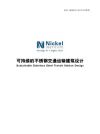Molybdenum and its applications
Stainless steel is an ideal material for transit buildings because of the high traffic flow, low maintenance, and longevity requirements. Type 316 is preferred for exterior and sheltered interior areas when there is exposure to coastal and deicing salt. It is also preferred for applications with urine exposure. It has also become increasingly popular to use Type 316 and high strength, corrosion resistant duplex stainless steels like 2205 to support low profile glass curtain walls and canopies.
These case studies and the brochure links show the effective use of stainless steel in these demanding buildings. Additional information about these and other projects can be found in the following article:
Sustainable Stainless Steel Transit Building Design
Sustainable Stainless Steel Transit Station Design
Jamaica Station, United States
Jamaica Station in the Queens section of New York City was significantly expanded in 2006, to link a new light rail system from JFK International Airport to the Long Island Rail Road, New York City Transit’s subway lines, and ground transportation. The addition is a seven-floor, 250,000 square-foot structure and it was designed as a gateway to the city. The design had to be attractive and functional, but, like all transit buildings, durability is important. The building features durable Type 316 stainless steel for demanding interior applications and roof panels.
The terminal’s large batten seam roof has carefully designed joints that allow controlled expansion and contraction in all directions. It also has high wind upload resistance. An internal drainage system was necessary because of the roof’s size and shape.


Photos: Courtesy of Contrarian Metal Resources
Views from either end of the Jamaica Station addition show its large, low-maintenance Type 316 stainless steel roof.
Numerous design considerations guided roof material selection, including proximity to the airport, a coastal location, moderate pollution levels, and the need for longevity and low-maintenance. Any large roof near an airport must have a low reflectivity surface finish so that pilots are not blinded. Type 316 (S31600, EN 1.4401, SUS 316) stainless steel was selected because it provides the desired corrosion performance and durability. Long-term maintenance was minimized by avoiding the need for a protective paint coating, which would deteriorate over time due to jet fuel residue, pollution, and coastal salt exposure. InvariMatte, a proprietary, textured, non-directional, low-reflectivity, finish from Contrarian Metal Resources was selected for the project because of its performance on similar projects.
Raffaello Sanzio Airport, Italy
Photos: Centro Inox
In 2008, the Raffaello Sanzo Airport added new arrival and departure terminal buildings. The airport is in Ancona-Falconara which is in the Marches region of Italy’s Adriatic coast. A light airy space was created by using glass exterior and interior walls. The glass is supported by Type 316 (S31600, EN 1.4401, SUS 316) stainless steel beams, rods, and fixtures. Excessive building heat gain was avoided by using Type 316 sun screens on the exterior window walls. The interior signage cable supports, hardware and door and window frames are also Type 316 stainless steel. More information about this project can be found in Inossidabile issue 175, which is the publication of the Italian stainless steel development organization Centro Inox.
Kowloon Station, China
Completed in 1998, Kowloon Station is on Hong Kong’s mass rail transit (MTR) Tung Chung and Airport Express lines and was part of the rail system built to connect the new airport with the city. The architect, Terry Farrell & Partners, selected a batten cap roof design from Overly Manufacturing Co. made from Type 316 (S31600, EN 1.4401, SUS 316) stainless steel, after other metal roofing systems failed to meet the project’s extremely high wind uplift requirements, with matching bull noses. These requirements were necessary to prevent damage during a typhoon.
Type 316 is commonly used for coastal locations because of its corrosion resistance. It will provide long-term strength and wind resistance in this coastal environment. Furthermore, the appearance will not deteriorate over time. The stainless steel has a proprietary low reflectivity rolled finish that looks similar to abrasive blasting. The stainless steel used for the roof is 0.635 mm (0.025 inch) and the bullnoses are 1.27 mm (0.050 inch) thick.









